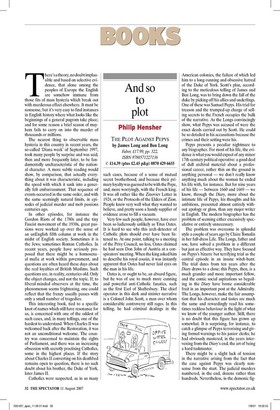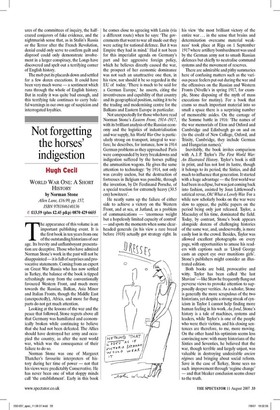And so to plot Philip Hensher THE PLOT AGAINST PEPYS
by James Long and Ben Long Faber, £17.99, pp. 322, ISBN 9780571227136 £14.39 (plus £2.45 p&p) 0870 429 6655 There's a theory, no doubt implausible and based on selective evidence, that alone among the peoples of Europe the English are somehow immune from those fits of mass hysteria which break out with murderous effect elsewhere. It must be nonsense, but it's very easy to find instances in English history where what looks like the beginnings of a general pogrom take place; and for some reason a brief season of mayhem fails to carry on into the murder of thousands or millions.
The nearest thing to observable mass hysteria in this country in recent years, the so-called 'Diana week' of September 1997, took many people by surprise and was said, then and more frequently later, to be fundamentally uncharacteristic of the national character. A more subtle reading would show, by comparison, that actually everything about it was characteristic, including the speed with which it sank into a generally felt embarrassment. That sequence of events occurred in the same order, and with the same seemingly natural limits, in episodes of judicial murder and mob passions centuries ago.
In other episodes, for instance the Gordon Riots of the 1780s and the tiny Fascist movement of the 1930s, great passions were worked up over the sense of an unEnglish fifth column at work in the midst of English society. Sometimes it is the Jews; sometimes Roman Catholics. In recent years, people have seriously proposed that there might be a homosexual mafia at work within government, and questions are often heard these days about the real loyalties of British Muslims. Such questions are, in reality, centuries old. Only the object changes, and not the topic. If, to liberal-minded observers at the time, the phenomenon seems frightening, one could reflect that the frenzy usually passes with only a small number of tragedies.
This interesting book, tied to a specific knot of names which still have resonance for us, is concerned with one of the oddest of such cases, and, in many tellings, one of the hardest to understand. When Charles II was welcomed back after the Restoration, it was not an unconditional welcome. The country was concerned to maintain the rights of Parliament, and there was an increasing obsession with secretly practising Catholics, some in the highest places. If the story about Charles II converting on his deathbed remains open to question, there is no such doubt about his brother, the Duke of York, later James II.
Catholics were suspected, as in so many such cases, because of a sense of mutual secret brotherhood, and because their primary loyalty was guessed to be with the Pope, and, more worryingly, with the French king. It was all rather like the Zinoviev Letter in 1924, or the Protocols of the Elders of Zion. People knew very well what they wanted to believe, and pretty soon a handy supplier of evidence arose to fill a vacuum.
Very few such people, however, have ever been so ludicrously unlikely as Titus Oates. It is hard to see why this arch-detector of Catholic plots should ever have been listened to. At one point, talking to a meeting of the Privy Council, no less, Oates claimed he had seen Don John of Austria at a conspirators' meeting. When the king asked him to describe his royal cousin, it was instantly apparent that Oates had never laid eyes on the man in his life.
Oates is, or ought to be, an absurd figure, but he was of use to much more cunning and powerful anti-Catholic fanatics, such as the first Earl of Shaftesbury. The chief operator in this dark and sinister narrative is a Colonel John Scott, a man over whom considerable controversy still rages. In this telling, he had criminal dealings in the American colonies, the failure of which led him to a long-running and obsessive hatred of the Duke of York. Scott's plan, according to the meticulous telling of James and Ben Long, was to bring down the fall of the duke by picking off his allies and underlings. One of these was Samuel Pepys. His trial for treason and the trumped-up charge of selling secrets to the French occupies the bulk of the narrative. As the Longs convincingly show, what Pepys was accused of were the exact deeds carried out by Scott. He could be so detailed in his accusations because the crimes and their setting were his.
Pepys presents a peculiar nightmare to any biographer. For most of his life, the evidence is what you would expect of any minor 17th-century political operative: a good deal of dull archival material about a professional career, rather thin on the ground in anything personal — we don't really know anything much about the woman he ended his life with, for instance. But for nine years of his life — between 1660 and 1669 — we know, through the Diary, more about the intimate life of Pepys, his thoughts and his ambitions, presented almost entirely without apology or gloss, than any major writer in English. The modern biographer has the problem of seeming either excessively speculative or entirely unnecessary.
The problem was overcome in splendid style a couple of years ago by Claire Tomalin in her full-dress Life. The Longs, father and son, have solved a problem in a different but just as effective way. They have focused on Pepys's bizarre but terrifying trial as the central episode in an insane witch-hunt. The trial dates from ten years after the Diary draws to a close; this Pepys, then, is a much grander and more important fellow, and the comic social aspirations so beguiling in the Diary have borne considerable fruit in an important post at the Admiralty. The Longs, however, make the fair assumption that his character and tastes are much the same and rewardingly read his sometimes reckless behaviour in the light of what we know of the younger author. Still, there is no doubt that this figure has grown up somewhat. It is surprising, for instance, to catch a glimpse of Pepys terrorising and giving formal warnings to his junior clerks; he had obviously mastered, in the years intervening from the Diary's end, the art of being a hard taskmaster.
There might be a slight lack of tension in the narrative arising from the fact that the case against Pepys was clearly nonsense from the start. The judicial murders numbered, in the end, dozens rather than hundreds. Nevertheless, in the demonic fig ures of the committees of inquiry, the halfcrazed conjurors of fake evidence, and the nightmarish sense that, as in Stalin's Russia or the Terror after the French Revolution, denial could only serve to confirm guilt and disproof could only demonstrate involvement in a larger conspiracy, the Longs have discovered and spelt out a terrifying corner of English history.
The mob put its placards down and settled for a few dozen executions. It could have been very much worse — a sentiment which runs through the whole of English history. But in reality it was quite bad enough, and this terrifying tale continues to carry baleful warnings in our own age of suspicion and interrogated loyalties.










































 Previous page
Previous page